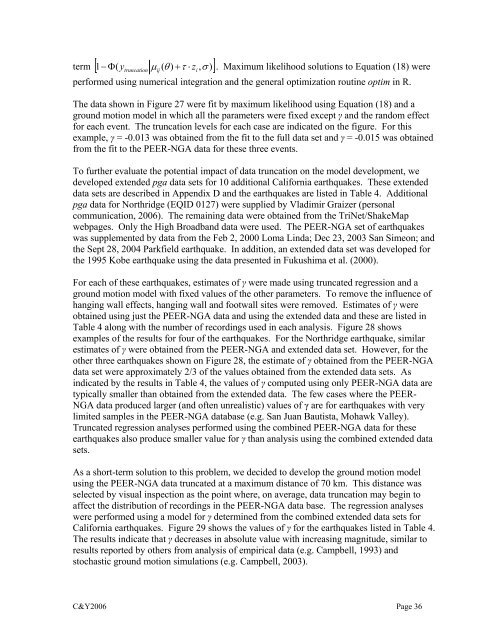Chiou and Youngs PEER-NGA Empirical Ground Motion Model for ...
Chiou and Youngs PEER-NGA Empirical Ground Motion Model for ...
Chiou and Youngs PEER-NGA Empirical Ground Motion Model for ...
You also want an ePaper? Increase the reach of your titles
YUMPU automatically turns print PDFs into web optimized ePapers that Google loves.
term [ 1 Φ(<br />
y ( θ ) + τ ⋅ z , σ ) ]<br />
− . Maximum likelihood solutions to Equation (18) were<br />
truncation μij i<br />
per<strong>for</strong>med using numerical integration <strong>and</strong> the general optimization routine optim in R.<br />
The data shown in Figure 27 were fit by maximum likelihood using Equation (18) <strong>and</strong> a<br />
ground motion model in which all the parameters were fixed except γ <strong>and</strong> the r<strong>and</strong>om effect<br />
<strong>for</strong> each event. The truncation levels <strong>for</strong> each case are indicated on the figure. For this<br />
example, γ = -0.013 was obtained from the fit to the full data set <strong>and</strong> γ = -0.015 was obtained<br />
from the fit to the <strong>PEER</strong>-<strong>NGA</strong> data <strong>for</strong> these three events.<br />
To further evaluate the potential impact of data truncation on the model development, we<br />
developed extended pga data sets <strong>for</strong> 10 additional Cali<strong>for</strong>nia earthquakes. These extended<br />
data sets are described in Appendix D <strong>and</strong> the earthquakes are listed in Table 4. Additional<br />
pga data <strong>for</strong> Northridge (EQID 0127) were supplied by Vladimir Graizer (personal<br />
communication, 2006). The remaining data were obtained from the TriNet/ShakeMap<br />
webpages. Only the High Broadb<strong>and</strong> data were used. The <strong>PEER</strong>-<strong>NGA</strong> set of earthquakes<br />
was supplemented by data from the Feb 2, 2000 Loma Linda; Dec 23, 2003 San Simeon; <strong>and</strong><br />
the Sept 28, 2004 Parkfield earthquake. In addition, an extended data set was developed <strong>for</strong><br />
the 1995 Kobe earthquake using the data presented in Fukushima et al. (2000).<br />
For each of these earthquakes, estimates of γ were made using truncated regression <strong>and</strong> a<br />
ground motion model with fixed values of the other parameters. To remove the influence of<br />
hanging wall effects, hanging wall <strong>and</strong> footwall sites were removed. Estimates of γ were<br />
obtained using just the <strong>PEER</strong>-<strong>NGA</strong> data <strong>and</strong> using the extended data <strong>and</strong> these are listed in<br />
Table 4 along with the number of recordings used in each analysis. Figure 28 shows<br />
examples of the results <strong>for</strong> four of the earthquakes. For the Northridge earthquake, similar<br />
estimates of γ were obtained from the <strong>PEER</strong>-<strong>NGA</strong> <strong>and</strong> extended data set. However, <strong>for</strong> the<br />
other three earthquakes shown on Figure 28, the estimate of γ obtained from the <strong>PEER</strong>-<strong>NGA</strong><br />
data set were approximately 2/3 of the values obtained from the extended data sets. As<br />
indicated by the results in Table 4, the values of γ computed using only <strong>PEER</strong>-<strong>NGA</strong> data are<br />
typically smaller than obtained from the extended data. The few cases where the <strong>PEER</strong>-<br />
<strong>NGA</strong> data produced larger (<strong>and</strong> often unrealistic) values of γ are <strong>for</strong> earthquakes with very<br />
limited samples in the <strong>PEER</strong>-<strong>NGA</strong> database (e.g. San Juan Bautista, Mohawk Valley).<br />
Truncated regression analyses per<strong>for</strong>med using the combined <strong>PEER</strong>-<strong>NGA</strong> data <strong>for</strong> these<br />
earthquakes also produce smaller value <strong>for</strong> γ than analysis using the combined extended data<br />
sets.<br />
As a short-term solution to this problem, we decided to develop the ground motion model<br />
using the <strong>PEER</strong>-<strong>NGA</strong> data truncated at a maximum distance of 70 km. This distance was<br />
selected by visual inspection as the point where, on average, data truncation may begin to<br />
affect the distribution of recordings in the <strong>PEER</strong>-<strong>NGA</strong> data base. The regression analyses<br />
were per<strong>for</strong>med using a model <strong>for</strong> γ determined from the combined extended data sets <strong>for</strong><br />
Cali<strong>for</strong>nia earthquakes. Figure 29 shows the values of γ <strong>for</strong> the earthquakes listed in Table 4.<br />
The results indicate that γ decreases in absolute value with increasing magnitude, similar to<br />
results reported by others from analysis of empirical data (e.g. Campbell, 1993) <strong>and</strong><br />
stochastic ground motion simulations (e.g. Campbell, 2003).<br />
C&Y2006 Page 36

















